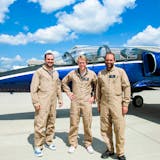In late January, as the polar vortex of 2019 gripped the Midwest, my group of friends were enjoying some rest and relaxation at a resort on Minnesota's icy North Shore. After checkout, one sensible couple fled to balmy Austin, Texas, for the second half of their vacation. But my companion and I pushed 100 miles farther north — to Thunder Bay, Ontario.
What can I say? When they go hot, we go cold.
The evocatively named Thunder Bay had always held some fascination for me. It's the largest city on Lake Superior (population: 108,000), and I imagined a Canadian version of Duluth. It's also the closest foreign city to Minneapolis. But when I first passed through a few years ago, I found only a sprawl of U.S. big-box stores, fast-food chains and strip malls. I was determined to return and find the soul of the city.
Over three days, we began to discover some of TBay's beauty and charms. An outdoorsy summer visit is in order, but we found plenty of food and fun to go along with the 30-below lows.
Giants and museums
One moment the Minnesotan visitor is driving north on Ontario's Hwy. 61 through pristine poplar and pine forest and flat-topped mesas. Suddenly he or she enters Thunder Bay through its back door, and the sprawl bewilders. With little in the way of a skyline, downtown seems elusive.
Thunder Bay makes more sense when you begin on its east end. That starts with the Sleeping Giant, a 3-mile mesa formation that is part of a popular provincial park, and keeps a drowsy sentinel from across the city's namesake bay (ontarioparks.com).
The Giant, and the city, can both be viewed from the Terry Fox Monument. In 1980, the 21-year-old Fox, with one leg amputated due to cancer, embarked on his trans-Canadian Marathon of Hope to raise money for cancer research. He was forced to end his run here, and died nine months later. The statue, which we visited during a colorful sunset, depicts Fox eternally running toward the West. He remains a Canadian folk hero, and a veritable symbol of Thunder Bay itself.
Still unclear about the city's place in the world, I headed to the Thunder Bay Museum (thunderbaymuseum.com). It turns out that Thunder Bay has no skyline because it was incorporated only in 1970, in an "amalgamation" of two smaller industrial towns, Fort William and Port Arthur.


